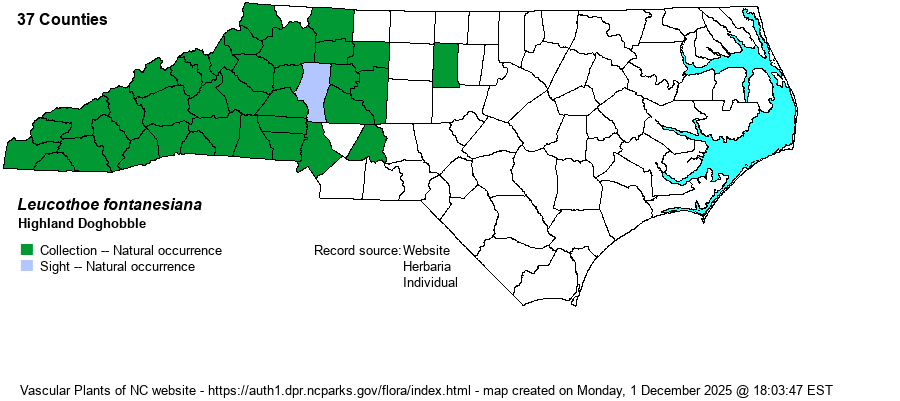| Author | (Steudel) Sleumer | |
| Distribution | Throughout the Mountains and foothills; ranges to the central Piedmont, east to Forsyth and Stanly counties; specimens and photos from Alamance County suggest that both Leucothoe species are present in this county. Records farther east (Orange County) might be of escaped individuals from plantings.
This species has a fairly small but “tight” distribution centered on the southern Appalachians. It ranges north only to southwestern VA, and south to northern GA and northeastern AL. It extends no farther west than east-central TN.
| |
| Abundance | Common to abundant across all of the Mountains, and common in the western Piedmont. It becomes scarce east to the central Piedmont. | |
| Habitat | This is a characteristic species of forested streamsides, lower parts of ravines, and wet woods, in acidic soils. It is usually associated with Rhododendron maximum, and to a lesser extent Kalmia latifolia. As with many shrubs, it can grow in extensive stands, especially linearly along creeks. | |
| Phenology | Blooms in April and May; fruits in September and October. | |
| Identification | This is a low shrub, usually only 2-3 feet tall. It has dark green, thick and leathery, evergreen leaves, making it easy to identify. The leaves taper strongly toward the tip and are not elliptical like many other shrub species. At most times of the year, flowers, buds, or capsules are visible on the twigs. Both Leucothoe species have abundant racemes of white urn-shaped flowers in the leaf axils, dangling downward. It differs from the very similar L. axillaris by this species having "Leaves long-acuminate, petiole (5-) 6-16 mm long; staminal filaments merely papillose; calyx lobes ovate or ovate-triangular to oblong-triangular, 0.7-1.6 mm wide; racemes 2-10 cm long, with 17-80 flowers; longest petioles 8-15 mm long", versus L. axillaris having "Leaves obtuse or acute to short-acuminate; staminal filaments almost always with at least a few unicellular hairs; calyx lobes ovate-triangular to ovate or widely so, 1.2-2.3 mm wide; racemes 0.9-5.5 cm long, with 8-44 flowers; sepals ovate, with an obtuse or rounded apex; longest petioles 2-10 (-11) mm long" (Weakley 2024). | |
| Taxonomic Comments | Most people probably recognize this entity as either Leucothoe editorum or Leucothoe axillaris var. editorum (RAB 1968 name). However, it has recently been shifted to a new name – L. fontanesiana.
| |
| Other Common Name(s) | Mountain Doghobble, Switch-ivy, Drooping Leucothoe, Drooping Fetterbush | |
| State Rank | S5 | |
| Global Rank | G5 | |
| State Status | | |
| US Status | | |
| USACE-agcp | FACW link |
| USACE-emp | FACW link |

